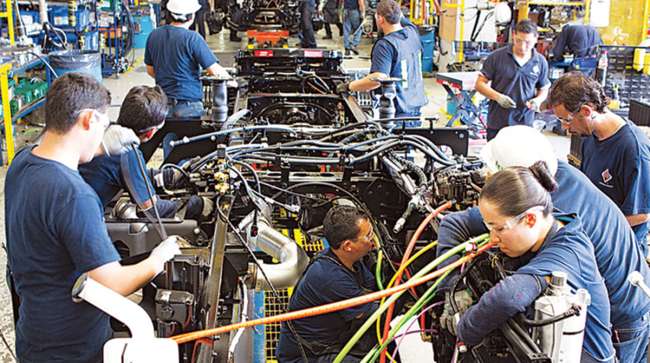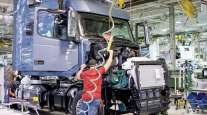Senior Reporter
April Class 8 Orders Cool; Supply Chain Woes Persist

[Stay on top of transportation news: Get TTNews in your inbox.]
North American Class 8 orders in April were 33,500, ACT Research reported, and the volume underscored how far the industry has rebounded from a year earlier when orders were the lowest since 1995.
ACT, citing truck makers’ preliminary data, said the orders were 689% higher than April 2020 (a month into the outbreak of the coronavirus pandemic) when they were 4,251. The orders were 16% below March’s 40,000 orders.
They were also the lowest since September, but that was to be expected, an ACT executive noted.
ACT Research: Preliminary NA Classes 5-8 Vehicle Orders Moderated in Aprilhttps://t.co/FIjPHGk1ZT — ACT Research (@actresearch) May 5, 2021
“April’s volume could easily have been 50,000 orders if the truck makers had capacity,” ACT Vice President Steve Tam said. “I do have to wonder what truck makers’ sales and marketing efforts look like because of the capacity restraints, for one, but, secondly, commodity prices. Steel is ridiculously expensive. Everything is going up, up, up.”
Last year about this time, there was talk of opening up the order boards for this year. But no truck maker has yet publicly announced it has opened its order book for 2022.
At the same time, Tam said the build rate in March was 28,000 units, and ACT is expecting that will fall to 21,000 in April, keeping the backlog high. “That is going to be a huge, huge decline and a pretty accurate reflection of how far up against it these manufacturers actually are.”
Meanwhile, “truckers are sitting in the driver’s seat, pun intended, when it comes to the sales of their services,” Tam said, “and because of that they are flush with cash looking for a home and it is going to flow to trucks and trailers.”
FTR pegged the orders at 34,600.
“With orders continuing at this pace,” said Don Ake, vice president of commercial vehicles at FTR, “it is possible that the supply chain will not be able to catch up with the fantastic truck demand for months.”
And it’s not just the truck makers facing difficulties.
Ake suggested about 20 truck maker suppliers are themselves experiencing difficulties in producing their routine parts.
He pointed out this winter’s dire storm in Texas temporarily curtailed production of resins and plastics at plants running at full capacity.
Ake said one of those suppliers told him ramping back amid heavy demand means the weather-related lost production cannot be made up “until things slow down.”
Peterbilt Truck Co. recently announced Yellow Corp. placed an order of 1,222 Peterbilt Model 579s — making it the single largest order of Peterbilt trucks equipped exclusively with a Paccar powertrain, according to the Denton, Texas, company, which is a unit of Paccar Inc.
“The orders are scheduled to be filled over a nine-month span,” a Peterbilt spokesman told Transport Topics. “The trucks are spec’d in a variety of configurations, and include Paccar’s MX-13 or MX-11 engines, as well as its TX-12 transmissions, exclusively. Yellow last ordered trucks from Peterbilt in 2016.”
Yellow Corp. ranks No. 6 on the Transport Topics Top 100 list of the largest for-hire carriers in North America.
Its operations include about 14,100 tractors.
Another truck maker’s production line has restarted.
Production resumed May 3 at Volvo Trucks North America’s New River Valley truck assembly operations in Dublin, Va., the truck maker told TT.
The plant shut down following a strike by the United Auto Workers that began April 19. It lasted until April 30 when they reached a tentative agreement on the terms of a new five-year contract that would cover approximately 2,900 employees.
Both sides May 6 told TT the contract still had not yet been ratified.
In the meantime, at vender Stoneridge Inc., reported supply chain issues have not prevented fleets from adopting its technology.

The year is 2039. Zero-emission, electric heavy-duty trucks roll past you on the highway. Charging ports are now commonplace at terminals and truck stops. Diesel-powered vehicles are becoming a thing of the past. You sit and wonder: How did we get here? Here, in 2021, Daimler Trucks North America's head of eMobility speaks to RoadSigns. Hear a snippet above, and get the full program by going to RoadSigns.TTNews.com.
“We continue to expand our MirrorEye [camera monitor system] platform as we prepare for our first OEM launches in the second half of 2021 and expand our retrofit programs,” Stoneridge CEO Jon DeGaynor said in a recent earnings call. “During the [first] quarter, we announced that two fleets, Maverick USA and Montgomery Transport [both of which are flatbed carriers], intend to install MirrorEye on 100% of their new trucks.”
Maverick USA ranks No. 76 on the TT for-hire Top 100.
MirrorEye is the first camera monitor system to receive a federal exemption from the Federal Motor Carrier Safety Administration, allowing MirrorEye-equipped trucks to operate on the road with an integrated system of cameras and digital displays as an alternative to conventional mirrors, according to Novi, Mich.,-based Stoneridge.
“With multiple truck makers bringing new technologies to market every year, configuring equipment has become complex and increasingly important to lowering fleet costs,” said Brian Holland, president of Fleet Advantage, which works on truck leasing packages for private and for-hire carriers.
Want more news? Listen to today's daily briefing below or go here for more info:




